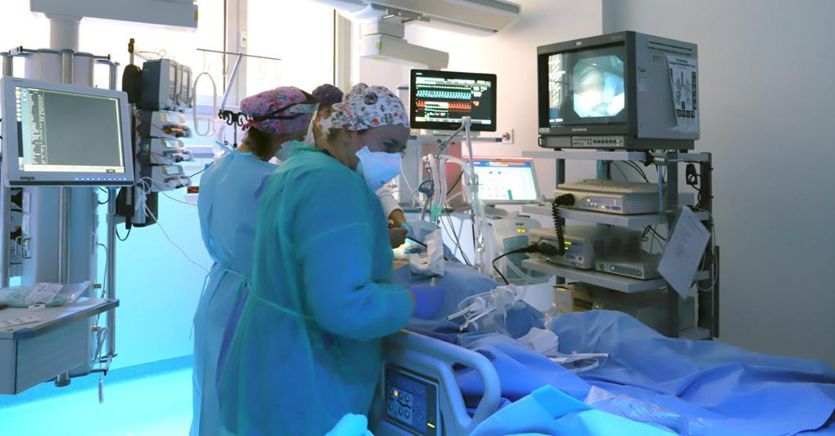Thanks to the vaccination campaign that protects against the most serious forms of Covid disease and with a pandemic that changes rapidly, the identikit of the patients involved is also changing. With the spread of the Omicron variant – which according to the WHO will arrive at a gallop to infect half of the population of the European region – the patient-centaur has now appeared in the wards: half with Covid, half suffering from other diseases and as such to be treated in a way different and in different care settings.
The “centaur” patient
The network of sentinel hospitals of Fiaso, the Federation of health and hospital companies, “found” it, which keeps its antennas straight on Covid “precisely to anticipate organizational solutions and to understand where we are going, a little before things happen ”, Explains the president Giovanni Migliore. Who continues: «This wave of Covid is very different from the first ones: thanks to vaccines we are not imprisoned at home and – finally – people go out, work and have a social life. But this also means that they return to have traumas or accidents or that they fall ill as they did a year ago, due to the reduced circulation of people, it didn’t happen anymore. This also requires different answers from us: if it is true that thanks to vaccines we have halved hospitalizations and intensive care units, it is also true that the variety of Covid patients who go to hospital forces us to make a greater organizational effort “. Because today patients arrive at the hospital. “Classic” Covid, that is with pulmonary pathology, non-Covid patients who must be followed and protected in “Covid free” paths and positive patients but without pulmonary pathology, with other concomitant diseases – the “centaurs”, in fact – to whom a ‘ organization in its own right. And there are not a few. The estimate is about 34%: over one in three who, according to the Federation, is hospitalized to treat anything else, such as trauma, heart attacks, hemorrhages, decompensation and tumors.
The Fiaso investigation
The data emerges from a study made by Fiaso on the admissions of six large hospitals and healthcare companies: the Civil Hospital of Brescia, the Irccs Policlinico S. Martino Hospital in Genoa, the Irccs Aou in Bologna, the Tor Vergata Polyclinic in Rome, the San Giuseppe Moscati hospital in Avellino and the Policlinico di Bari. In all, 550 patients hospitalized in the Covid areas of the six structures were analyzed, for a sample equal to 4% of the total hospitalized in Italian hospitals. 363 (66%) are hospitalized with a diagnosis of lung infection, while 187 (34%) do not show clinical, radiographic and laboratory signs of lung involvement. So – the investigation finds – they were hospitalized not for the virus but with the virus. Mostly these are patients who have arrived in the hospital or the emergency room for other problems and who, at the time of admission that includes the swab, are carriers of Sars-Cov-2 infection but without symptoms of disease.
Occasional Covid diagnosis
The diagnosis is therefore occasional. The overwhelming majority, 36% of the total number of positive patients without respiratory symptoms, are pregnant women who need obstetric and gynecological assistance. 33%, on the other hand, is made up of patients who have suffered a decompensation of the internal condition deriving from diabetes or other metabolic diseases, from cardiovascular, neurological, oncological diseases or chronic bronchopneumopathies. An 8% are people with ischemias, strokes, cerebral hemorrhages or heart attacks and another 8% are patients who must undergo an urgent and non-postponable surgery even if “positive”. There are also 6% of individuals who come to the emergency room after accidents require assistance for trauma and fractures.
The priority: reorganize assistance
Will it be a small impromptu army, destined to disperse in a short time? Not at all, according to Migliore “already today we find ourselves redundant departments and personnel to meet the needs of tripartite assistance and there is no doubt that this will be the future, at least for the next few years. Different assistance, both hospital and territorial, will have to be organized. With the vaccination campaign we will significantly reduce the circulation of the virus but we will still have to imagine paths that guarantee greater safety for patients. Because in a situation that is likely to become endemic, we will find more and more patients who, thanks to vaccines, will not have developed major lung disease but who will still be positive, to be treated in dedicated courses “. Some structures have already moved by activating mixed clinical skills and interdisciplinary assistance. It is necessary to think of Covid departments for cardiothoracic, for multi-specialist surgery. For obstetrics, Covid areas have already been created in many hospitals, while in Brescia and Bari there are also clinics for dialysis of positive patients. In Bari-Fiera del Levante the emergency pavilion has 150 beds in 16-bed modules, where internal doctors, physiatrists, resuscitators, pulmonologists, nephrologists work.
